The Night Sky December 2013
Compiled by Ian Morison
This page, updated monthly, will let you know some of the things that you can look out for in the night sky. It lists the phases of the Moon, where you will see the naked-eye planets and describes some of the prominent constellations in the night sky during the month.
Image of the Month
Comet ISON: RIP
Image: Damian Peach
ISON, the comet that few of us saw. I had hoped to show you how to look for what some had predicted would be the comet of the century during the early part of December. Sadly, as I write on the morning after ISON passed close behind the Sun on the 28th November, it looks as though Suns gravitational forces broke it up and little has emerged to give us a spectacular sight this December. This image, by the renowned Solar
Postscript: December 3rd. Shown below is a composite image of the final hours of comet ISON as it rounded the Sun. As of December 2nd, it was just a
To see more of Damian Peach's wonderful images of the solar system: Damian Peache's website
Highlights of the Month
December - the first good month to view Jupiter.
This is the first of several great months to observe Jupiter. It now lies Gemini and so is high in the ecliptic and hence, when due south, at an elevation of ~60The features seen in the Jovian atmosphere have been changing quite significantly over the last few years - for a while the South Equatorial Belt vanished completely (as seen in Damian's image) but has now returned to its normal wide state. The diagram on right shows the main Jovian features as imaged by the author at the beginning of December 2012.
The image by Damian Peach was taken with a 14 inch telescope in Barbados where the seeing can be particularly good. This image won the "Astronomy Photographer of the Year" competition in 2011. See more of Damian Peach's images: Damian Peaches Website"
December 5th/6th - after sunset: Venus with a thin crescent Moon
About 45 minutes after sunset on the 5th and 6th and given a low horizon in the west-southwest one should be able to observe Venus over to the left of a thin crescent Moon.Around the 1st to 6th December - Find M31, The Andromeda Galaxy - and perhaps M33 in Triangulum - with no Moon in the sky.
In the evening, the galaxy M31 in Andromeda is visible in the south-west. The chart provides two ways of finding it:1) Find the square of Pegasus. Start at the top left star of the square - Alpha Andromedae - and move two stars to the left and up a bit. Then turn 90 degrees to the right, move up to one reasonably bright star and continue a similar distance in the same direction. You should easily spot M31 with binoculars and, if there is a dark sky, you can even see it with your unaided eye. The photons that are falling on your retina left Andromeda well over two million years ago!
2) You can also find M31 by following the "arrow" made by the three rightmost bright stars of Cassiopeia down to the lower right as shown on the chart.
Around new Moon (3rd December) you may also be able to spot M33, the third largest galaxy after M31 and our own galaxy in our Local Group of galaxies. It is a face on spiral and its surface brightness is pretty low so a dark, transparent sky will be needed to spot it using binoculars (8x40 or, preferably, 10x50). Follow the two stars back from M31 and continue in the same direction sweeping slowly as you go. It looks like a piece of tissue paper stuck on the sky just a bit brighter than the sky background. Good Hunting!
December 14th and 15th after midnight: the Geminid Meteor Shower.
The GeminidsThe early mornings of December 14th and 15th will give us the chance, if clear, of observing the peak of the Geminid meteor shower. Sadly, this is not a good year, as a waxing Gibbous Moon high in Aries will hinder our view This means that you will only see the brighter trails by looking high up away from the glare of the Moon. An observing location well away from towns or cities will also pay dividends though. The relatively slow moving meteors arise from debris released from the asteroid 3200 Phaethon. This is unusual, as most meteor showers come from comets. The radiant - where the meteors appear to come from - is close to the bright star Castor in the constellation Gemini as shown on the chart. If it is clear it will be cold - so wrap up well, wear a woolly hat and have some hot drinks with you.
December 22nd/23rd - midnight onwards : the Ursid Meteor Shower
The night of the 22nd/23rd December is when the Ursid meteor shower is at its best - though the peak rate of ~10-15 meteors per hour is not that great. The waning gibbous Moon lies in Leo - opposite in the sky - so moonlight will not greatly obstruct our view in the hours before dawn. The radiant lies close to the star Kochab in Ursa Minor (hence their name), so look northwards at a high elevation. Occasionally, there can be a far higher rate so its worth having a look should it be clear.Around December 1st to 6th : Search for Neptune - with no Moon in the sky.
Neptune, with a magnitude of 7.8 should be easily seen in binoculars under a dark, early evening, sky. It will be due south around 18:30 in the evening. Neptune lies about 2 degrees above the star Iota Aquarii as shown on the chart. Iota Aquarii can be found by moving 5 degrees to the left and slightly upwards from the star Delta Capricorni.December - 11th and 24th: The Alpine Valley
An interesting valley on the Moon: The Alpine ValleyThese are good nights to observe an interesting feature on the Moon if you have a small telescope. Close to the limb is the Appenine mountain chain that marks the edge of Mare Imbrium. Towards the upper end you should see the cleft across them called the Alpine valley. It is about 7 miles wide and 79 miles long. As shown in the image a thin rill runs along its length which is quite a challenge to observe. Over the next two nights following the 3rd/4th the dark crater Plato and the young crater Copernicus will come into view. This is a very interesting region of the Moon!
M 109 imaged with the Faulkes Telescope
Spiral galaxy M109, imaged by Daniel Duggan.This image was taken using the Faulkes Telescope North by Daniel Duggan - for some time a member of the Faulkes telescope team. M 109 is a Barred Spiral some 83 million light years away that lies is a loose collection of Galaxies called the Ursa Major Cloud that may contain over 50 galaxies.
Learn more about the Faulkes Telescopes and how schools can use them: Faulkes Telescope"
Observe the International Space Station

The International Space Station and Jules Verne passing behind the Lovell Telescope on April 1st 2008.
Image by Andrew Greenwood
Note: I observed the ISS three times recently and was amazed as to how bright it has become.
Find details of sighting possibilities from your location from: Location Index
See where the space station is now: Current Position
The Moon

The Moon at 3rd Quarter. Image, by Ian Morison, taken with a 150mm Maksutov-Newtonian and Canon G7.
Just below the crator Plato seen near the top of the image is the mountain "Mons Piton". It casts a long shadow across the maria from which one can calculate its height - about 6800ft or 2250m.
| new moon | first quarter | full moon | last quarter |
|---|---|---|---|
| December 3rd | December 9th | December 17th | December 25th |
A World Record Lunar Image
To mark International Year of Astronomy, a team of British astronomers have made the largest lunar image in history and gained a place in the Guinness Book of Records! The whole image comprises 87.4 megapixels with a Moon diameter of 9550 pixels. This allows details as small as 1km across to be discerned! The superb quality of the image is shown by the detail below of Plato and the Alpine Valley. Craterlets are seen on the floor of Plato and the rille along the centre of the Alpine valley is clearly visible. The image quality is staggering! The team of Damian Peach, Pete lawrence, Dave Tyler, Bruce Kingsley, Nick Smith, Nick Howes, Trevor Little, David Mason, Mark and Lee Irvine with technical support from Ninian Boyle captured the video sequences from which 288 individual mozaic panes were produced. These were then stitched together to form the lunar image.Please follow the link to the Lunar World Record website and it would be really great if you could donate to Sir Patrick Moore's chosen charity to either download a full resolution image or purchase a print.
The Planets
Jupiter is now well placed in the late evening sky at the start of an excellent apparition.
Jupiter
Jupiter rises about 7:30 pm at the beginning of December and by late evening dominates the eastern sky. It transits (due South) at 3 am when it will be ~62 degrees above the horizon (in the UK)shining at magnitude -2.6 with a disk ~46 arc seconds across. Jupiter is lying in the constellation Gemini very close the the 3.5 magnitude star, Wasat - Delta Geminorum and, on the 10th, will lie just 15 arc minutes above Wasat. It is now moving in retrograde motion westwards across the sky. By month's end Jupiter will rise at 6 pm and transit at 2 am so will be high in the western sky as dawn breaks having a magnitude of -2.7 and a diameter of nearly 47 arc seconds. With a small telescope you can observe the 4 Gallilean moons as they weave there way around it and, at times, be also able to pick out the Great Red Spot visible as an indentation of the South Equatorial belt.See the highlight above.
Saturn
Saturn. Having passed behind the Sun in early November Saturn is now visible in the pre-dawn sky, rising at about 5 am as December begins and at about 3:30 am at its end. It is shining with a magnitude of +0.6 and its disk has a diameter of ~15.5 arc seconds. The really good news is that the rings have now opened to around 21 degrees from the line of sight so present a magnificant view. Sadly for those of us in the northern hemisphere, Saturn is now lying in the more southerly part of the ecliptic so, even at opposition, its elevation does not get that high. Even worse, this will not improve for many years to come.Mars
Mars, lying in Virgo, rises soon after midnight at the start of the month shining at magnitude +1.2. Its magnitude increases to +0.9 during the month with its angular size increasing from 5.6 to 6.8 arc seconds. So, given good seeing, it is possible to see markings on its salmon-pink surface such as the polar caps and Syrtis Major. So, we can say that Mar's apparition has really begun. Mars is moving down across Virgo and, at the very end of the month is very close to Porrima, Gamma Virginis.Mercury
Mercury is visible in the pre-dawn sky shining at magnitude +0.6 down to the lower left of Saturn as December begins. It brightens to -0.8 magnitudes during the first couple of weeks but, each morning. is a little lower above the horizon as dawn breaks and will be lost from view by mid December and passes behind the Sun (superior conjunction) on December 29th.Venus
Venus shines at magnitude -4.9 in early December - a beacon in the western sky. However at this time of year the ecliptic is at quite a shallow angle to the horizon and, even worse, Venus, with a declination of -27, is very close to its furthest southern declination. The result is that it will lie close to the horizon in the south south-west and so, with an elevation of ~15 degrees above the horizon at sunset it will not be as prominent as one might expect. It is, however, very interesting to observe how its phase thins from 30 to 11% arc seconds during the first three weeks of the month whilst its angular size increases from 38 to 53 arc seconds. By month's end the phase has reduced to just 4% and it is almost one arc minute across. Venus pases in front of the Sun (inferior conjunction) on the 11th of next month.See the highlight above.
Find more planetary images and details about the Solar System: The Solar System
The Stars
The Late Evening December Sky
This maps shows the constellations seen towards the south in early and late evening. Setting towards the west in early evening is the beautiful region of the Milky Way containing both Cygnus and Lyra. Below is Aquilla. The three bright stars Deneb (in Cygnus), Vega (in Lyra) and Altair (in Aquila) make up the "Summer Triangle". East of Cygnus is the great square of Pegasus - adjacent to Andromeda in which lies M31, the Andromeda Nebula. To the north lies "w" shaped Cassiopeia and Perseus. The lower map shoesthe constellation Taurus, with its two lovely clusters, the Hyades and the Pleaides, and is also described in more detail below. as the evening draws on, Orion, the Hunter, follows Taurus into the eastern sky with the constellations Auriga, above, and Gemini, to the upper left. Later Sirius, in Canis Major will be seen to the lower left of Orion. Due to its brightness and scintillations caused by the atmosphere it often appears as a rainbow of colours flashing in the sky.The constellations Pegasus and Andromeda
PegasusThe Square of Pegasus is in the south during the evening and forms the body of the winged horse. The square is marked by 4 stars of 2nd and 3rd magnitude, with the top left hand one actually forming part of the constellation Andromeda. The sides of the square are almost 15 degrees across, about the width of a clentched fist, but it contains few stars visibe to the naked eye. If you can see 5 then you know that the sky is both dark and transparent! Three stars drop down to the right of the bottom right hand corner of the square marked by Alpha Pegasi, Markab. A brighter star Epsilon Pegasi is then a little up to the right, at 2nd magnitude the brightest star in this part of the sky. A little further up and to the right is the Globular Cluster M15. It is just too faint to be seen with the naked eye, but binoculars show it clearly as a fuzzy patch of light just to the right of a 6th magnitude star.
Andromeda
The stars of Andromeda arc up and to the left of the top left star of the square, Sirra or Alpha Andromedae. The most dramatic object in this constellation is M31, the Andromeda Nebula. It is a great spiral galaxy, similar to, but somewhat larger than, our galaxy and lies about 2.5 million light years from us. It can be seen with the naked eye as a faint elliptical glow as long as the sky is reasonably clear and dark. Move up and to the left two stars from Sirra, these are Pi amd Mu Andromedae. Then move your view through a rightangle to the right of Mu by about one field of view of a pair of binoculars and you should be able to see it easily. M31 contains about twice as many stars as our own galaxy, the Milky Way, and together they are the two largest members of our own Local Group of about 3 dozen galaxies.
M33 in Triangulum
If, using something like 8 by 40 binoculars, you have seen M31 as described above, it might well be worth searching for M33 in Triangulum. Triangulum is
the small faint constellation just below Andromeda. Start on M31, drop down to Mu Andromedae and keep on going in the same direction by the same distance as you have moved from M31 to Mu Andromedae. Under excellent seeing conditions (ie., very dark and clear skies) you should be able to see what looks like a little piece of tissue paper stuck on the sky or a faint cloud. It appears to have uniform brightness and shows no structure. The shape is irregular in outline - by no means oval in shape and covers an area about twice the size of the Moon. It is said that it is just visible to the unaided eye, so it the most distant object in the Universe that the eye can see. The distance is now thought to be 3.0 Million light years - just greater than that of M31.
The constellation Taurus
Taurus is one of the most beautiful constellations and you can almost imagine the Bull charging down to the left towards Orion. His face is delineated by the "V" shaped cluster of stars called the Hyades, his eye is the red giant star Aldebaran and the tips of his horns are shown by the stars beta and zeta Tauri. Although alpha Tauri, Aldebaran, appears to lie amongst the stars of the Hyades cluster it is, in fact, less than half their distance lying 68 light years away from us. It is around 40 times the diameter of our Sun and 100 times as bright.More beautiful images by Alson Wong : Astrophotography by Alson Wong
To the upper right of Taurus lies the open cluster, M45, the Pleiades. Often called the Seven Sisters, it is one of the brightest and closest open clusters. The Pleiades cluster lies at a distance of 400 light years and contains over 3000 stars. The cluster, which is about 13 light years across, is moving towards the star Betelgeuse in Orion. Surrounding the brightest stars are seen blue reflection nebulae caused by reflected light from many small carbon grains. These relfection nebulae look blue as the dust grains scatter blue light more efficiently than red. The grains form part of a molecular cloud through which the cluster is currently passing. (Or, to be more precise, did 400 years ago!)
Close to the tip of the left hand horn lies the Crab Nebula, also called M1 as it is the first entry of Charles Messier's catalogue of nebulous objects. Lying 6500 light years from the Sun, it is the remains of a giant star that was seen to explode as a supernova in the year 1056. It may just be glimpsed with binoculars on a very clear dark night and a telescope will show it as a misty blur of light.
Its name "The Crab Nebula" was given to it by the Third Earl of Rosse who observed it with the 72 inch reflector at Birr Castle in County Offaly in central Ireland. As shown in the drawing above, it appeared to him rather lile a spider crab. The 72 inch was the world's largest telelescope for many years. At the heart of the Crab Nebula is a neutron star, the result of the collapse of the original star's core. Although only around 20 km in diameter it weighs more than our Sun and is spinning 30 times a second. Its rotating magnetic field generate beams of light and radio waves which sweep across the sky. As a result, a radio telescope will pick up very regular pulses of radiation and the object is thus also known a Pulsar. Its pulses are monitored each day at Jodrell Bank with a 13m radio telescope.
The constellation Orion
Orion, perhaps the most beautiful of constellations, will be seen in the south at around 11 - 12 pm during January. Orion is the hunter holding up a club and shield against the charge of Taurus, the Bull up and to his right. Alpha Orionis, or Betelgeuse, is a read supergiant star varying in size between three and four hundred times that of our Sun. The result is that its brightness varies somewhat. Beta Orionis, or Rigel, is a blue supergiant which, at around 1000 light years distance is about twice as far away as Betelgeuse. It has a 7th magnitude companion. The three stars of Orion's belt lie at a distance of around 1500 light years. Just below the lower left hand star lies a strip of nebulosity against which can be seen a pillar of dust in the shape of the chess-board knight. It is thus called the Horsehead Nebula. It shows up very well photographically but is exceedingly difficult to see visually - even with relativly large telescope.Beneath the central star of the belt lies Orion's sword containing one of the most beautiful sights in the heavens - The Orion Nebula. It is a region of star formation and the reddish colour seen in photographs comes from Hydrogen excited by ultraviolet emitted from the very hot young stars that make up the Trapesium which is at its heart. The nebula, cradling the trapesium stars, is a beautiful sight in binoculars or, better still, a telescope. To the eye it appears greenish, not red, as the eye is much more sensitive to the green light emitted by ionized oxygen than the reddish glow from the hydrogen atoms.

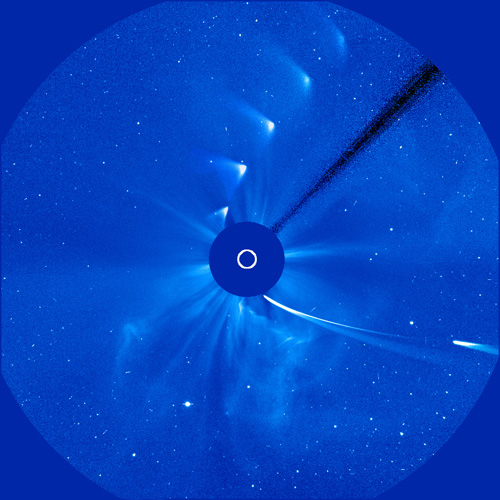
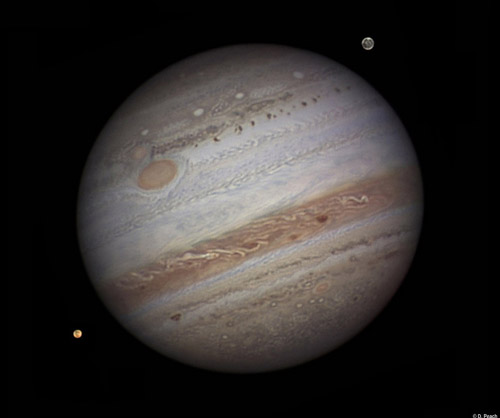
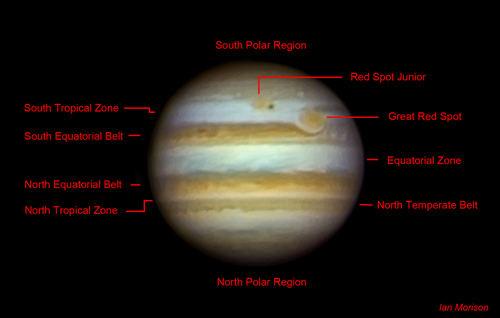
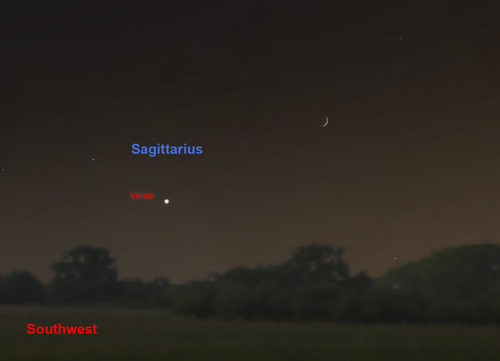
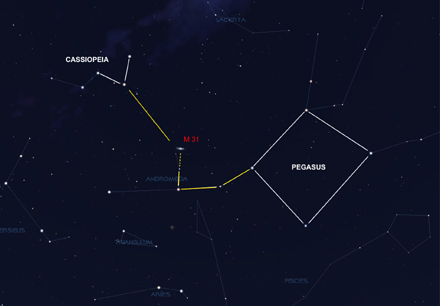
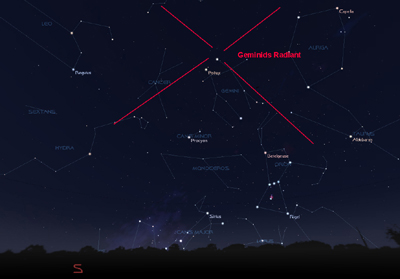
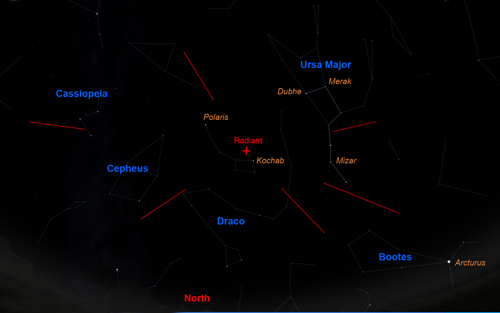
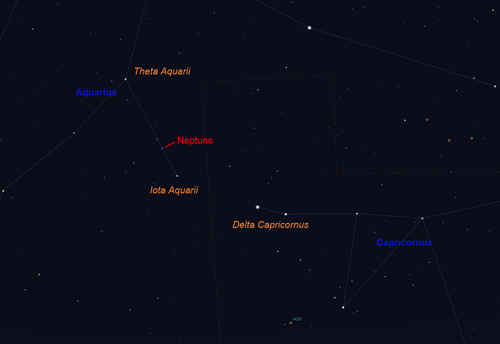
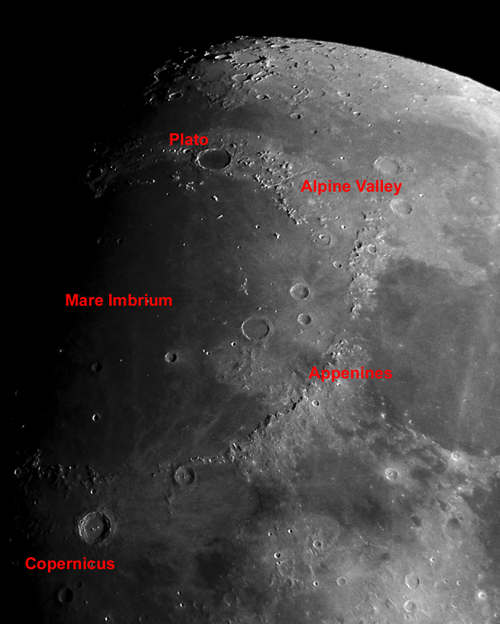











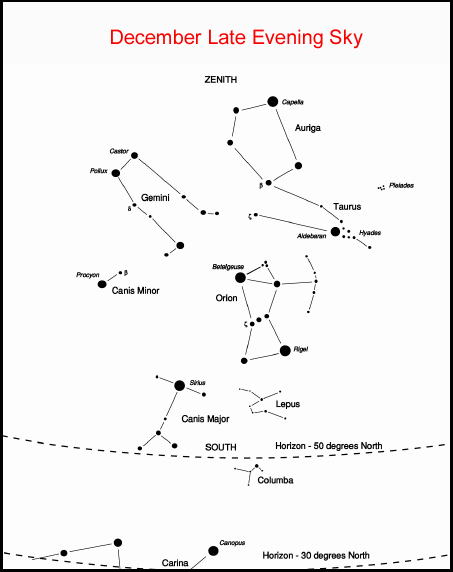


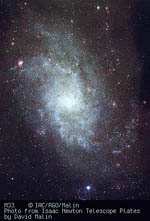

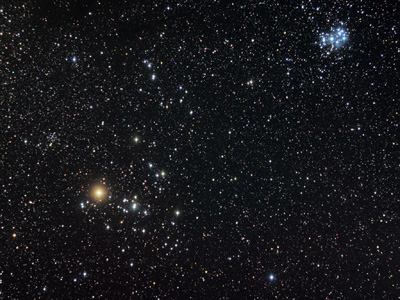


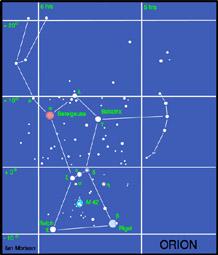
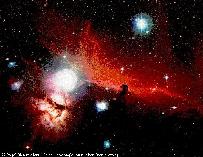
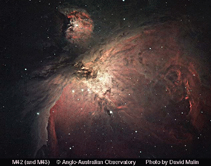
No comments:
Post a Comment